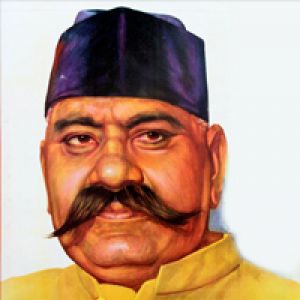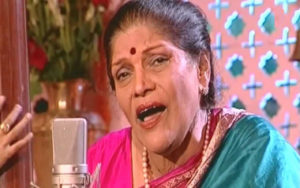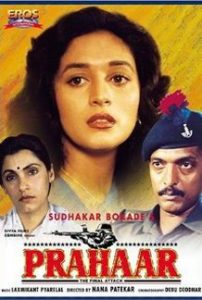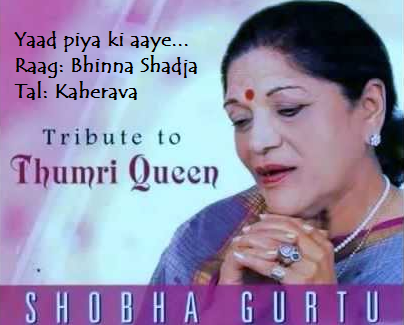Raaga Based Song of the Day: Yaad piya ki aaye…
Raag Bhina Shadaj (Bhinna Shadja), Tal Kaherava
(a Thumri by Shobha Gurtu)
We have completed forty days of Raaga Based Songs of the Day. Our first post in the series was titled ‘Raaga Based Song Of The Day #1’ and the song was a Mohammad Rafi and Lata Mangeshkar song from the 1970 Shakti Samanta movie Pagla Kahin Ka: Tum mujhe youn bhula na paoge. It is in Raag Jhinjhoti, Tal Kaherava.
Our fortieth post was titled ‘Raaga Based Song Of The Day #40’ and the song was a Swaranlatha & Hariharan song from the 1995 Ram Gopal Verma movie Rangeela: Haay Rama ye kyaa hua. It is in Raag Puria Dhanashri, Tal Kaherava.
This blog has a number of posts on Raaga based songs in Hindi movies titled similarly; for example: ‘The Best Raaga Based Songs in Hindi Movies – Raaga Jhinjhoti – Part I‘.
In the last forty days of sharing Raaga based songs of the day, I have given you songs based on Raag Jhinjhoti, Gara, Bhimpalasi, Madhuvanti, Shivaranjani, Bihag, Pahadi, Sarang, Pilu, Bhairavi, Khammaj, Charukesi, Kalyan or Yaman, Desh, Malgunji, Kirwani, Kedar, Bageshri, Megh Malhar, Bhupali, Ahir Bhairav, Malkaush, Adana, Kafi, Rageshri, Jaunpuri, Tilang, Janasammohini, Chayanat, Shuddha Kalyan, Gaur Sarang, Jogiya, Asavari, Maru Bihag, Durga, Lalit and Puria Dhanashri. The only raag that has been repeated so far is Pahadi, the raaga of my home place.
Today, I give you a song in Raag Bhinna Shadaj, Tal Kaherava.
However, first, lets take up the value added learning of today. Today, we shall learn about Kajri:
Kajri is another light classical genre of Hindustani music. Kajri (or Kajari), derived from the Hindi word Kajra or Kajal, (meaning Kohl or Black), is a genre of Hindustani classical music, popular in Uttar Pradesh and Bihar. In a country of sizzling hot summers, the black monsoon clouds bring with them relief and great joy. This is the moment for the Kajri to be sung. Even though Kajri is sung in a large region, Mirzapur is considered the real home of the Kajri. According to a folk tale of Mirzapur, there was woman called Kajli whose husband was in a distant land. Monsoon arrived and the separation became unbearable and she started crying at the feet of the Kajmal Goddess. These cries took the form of the popular Kajri songs. There are two forms of Kajri singing in UP: one within which it is sung on a performance platform and the other when it is sung by women on monsoon evenings, while dancing in a semi-circle; this is known as the ‘Dhunmuniya Kajri’.
Some noted exponents of Kajari are Pandit Channulal Mishra, Shobha Gurtu, Siddheshwari Devi, Girija Devi, Ustad Bismillah Khan, Sharda Sinha and Rajan and Sajan Mishra.
For today’s Thumri rendition by Shobha Gurtu, I am retaining yesterday’s distinction between Thumri and Dadra:
- As I have already told you Thumri is slower and Dadra is faster.
- Thumri has lengthy structure of improvisation whereas Dadra is crisp and compact.
- Thumri has lyrics with just two parts: Sthayi and Antara, whereas lyrics of Dadra have more than one Antara.
- Thumri as you know is mostly about human love relationship, whereas Dadra has seasons, nature and human relationships as subjects.
As I mentioned, today’s song is composed in Raag Bhinna Shadaj, Tal Kaherava.
Bhinna Shadaj, also known as Hindoli or Kaushik Dhwani, is a raaga that belongs to Bilawal Thaat. Its Jati is Audhav – Audhav, ie, five notes in Aaroha and five in Avroha. The time for performing this raaga is midnight.
What is the meaning of the word Bhinna or भिन्न? All people, even with elementary knowledge of Hindi would know that Bhinna or भिन्न means ‘Different’. In the case of the present raaga under discussion, it is different in case of Shruti, Swar, Jati and Purity (Shuddha). Naturally it belongs to Audhav – Audhav Jati (I have already told you, at a very early stage in the present series, that the seven basic swaras of the scale are named Shadja, Rishabh, Gandhar, Madhyam, Pancham, Dhaivat and Nishad, and are shortened to Sa, Ri (Carnatic) or Re (Hindustani), Ga, Ma, Pa, Dha, and Ni). Bhinna Shadja doesn’t have Rishabh and Pancham, has Dhaivat as its initial and basic note and Madhyam as its final note.
The bhaav of the raaga is Shaant-Gambheer.
Two of the other songs composed in Raag Bhinna Shadaj are: Udd ja re kaaga from the Meera bhajan album: Dhala Vahi Des, and Tum bin jeewan kaisa jeewan from the movie Bawarchi.

I could have given you a thumri bandish by Ustad Bade Ghulam Ali Khan. However, I have thought of giving you this rendition by Thumri Queen Shobha Gurtu. After the partition of India in 1947, Ustad Bade Ghulam Ali Khan went to his hometown Kasur in Pakistan, but returned to India later to reside permanently there in 1957, with the help of Bombay Chief Minister Morarji Desai, he acquired Indian citizenship and moved to a bungalow at Malabar Hill in Mumbai. If you recall, in K Asif’s movie Mughal-e-Azam, Ustad Bade Ghulam Ali Khan sang two songs based on Raag Sohni and Rageshri: Prem jogan ban ke and Shubh din aayo raj dulara. In order to deter K Asif from making him sing in his movie, he asked for Rupees 25000 per song (Lata and Mohammad Rafi were getting Rupees 500 per song at that time). To his surprise, K Asif agreed.
Hence, to sing this beautiful Thumri penned by Ustad Bade Ghulam Ali Khan, I have chosen Shobha Gurtu, who had him as one of her greatest influences.

Shobha Gurtu was born as Bhanumati Shirodkar in Belgaum (now Karnataka) in 1925. She was first trained by her mother Menekabai Shirodkar, a professional dancer, and a ‘gayaki’ disciple of Ustad Alladiya Khan of the Jaipur-Atrauli gharana. Ustad Alladiya Khan’s son Ustad Bhurji Khan trained her. She was thus associated in a huge manner with the Jaipur-Atrauli gharana. Later, she started learning from Ustad Natthan Khan, nephew of Ustad Alladiya Khan. Her training was, however, completed under Ustad Ghamman Khan who shifted with them in Mumbai.
Shobha Gurtu became an exponent of classical forms such as Thumri, Dadra, Kajri, and Hori, all of which I have told you about. With her intense training in classical singing, she was able to add classical passages into her singing. She was known as the Thumri Queen of India, having revived this form of semi-classical singing. Her main influences were Begum Akhtar and Ustad Bade Ghulam Ali Khan. She has also sung a few songs in Hindi movies such as in 1972 Pakeezah (Bandhan bandho composed by Ghulam Mohammad), 1973 Phagun (Bedardi ban gaye koi jaao manaao more saiyyaan composed by SD Burman) and 1978 Main Tulsi Tere Aangan Ki (Sainya rooth gaye composed by Laxmikant Pyarelal).
Shobha Gurtu was the recipient of Sangeet Natak Akademi Award in 1987 and Padma Bhushan in 2002.
 Please enjoy Shobha Gurtu sing a Thumri in Raag Bhinna Shadja, Tal Kaherava: Yaad piya ki aaye……. (The song was penned by Ustad Bade Ghulam Ali Khan at the passing away of his wife in 1932) (She sang it also for the movie Prahar, as a composition of Laxmikant Pyarelal)
Please enjoy Shobha Gurtu sing a Thumri in Raag Bhinna Shadja, Tal Kaherava: Yaad piya ki aaye……. (The song was penned by Ustad Bade Ghulam Ali Khan at the passing away of his wife in 1932) (She sang it also for the movie Prahar, as a composition of Laxmikant Pyarelal)
yAd piyA kI AyE
yeh dukh sahA na jAyE – hAyE rAm
bAlI umariyA sUnI rI sajariyA
jOban bItO / bItA jAyE – hAyE rAm
bairI koyaliyA kUk sunAyE
mujh birhan kA jiyarA jalAyE
hA.n – pI bin rain jagAyE (alt: rahA nA jAyE ) – hAyE rAm
(Oh memories of my beloved haunt me! Alas, I cannot bear this grief! I am yet young but my bed is forlorn; my youth is passing by – Alas! The cuckoo, my enemy, coos his song. Bereft of my beloved, my heart burns. Yes, I am kept awake all night without my beloved! Alas!)
We have intended to learn about Raaga based music whilst we entertain ourselves with Raaga based songs. So, lets, once again, take stock of our collective learning so far:
- On the first day we learnt about the Raaga system devised by Pandit Vishnu Narayan Bhatkhande, which is the prevalent system in Hindustani Classical Music and based on ten Thaats.
- On the second day we learnt about Tal or Taal.
- On the third day we learnt about characteristics of Raagas that included Swar, Jati, Thaat, Arohana and Avarohana, Vadi, Samvadi and Pakad.
- On the fourth day, we learnt about Sargam.
- On the fifth day, we learnt about notations used in Indian classical music or simply Swar Lipi.
- On the sixth day, we learnt about the Ras (sentiments) that Raagas evoke.
- On the seventh day, we learnt about various types of Swar: Shuddha, Achal, Vikrut, Komal and Teevra.
- On the eighth day, we learnt the parts of a composition in Indian Classical Music.
- On the ninth day, we learnt the names of some of the popular instruments used in Indian Classical Music.
- On the tenth day, we learnt about the sources of names of Raagas.
- On the eleventh day, we learnt about why Bhairavi is the first raag to be taught to beginners and also why it is the last in a performance.
- On the twelfth day, we learnt about Khammaj Thaat.
- On the thirteenth day, we learnt about Tal Punjabi Theka or Sitarkhani.
- On the fourteenth day, we learnt about Alap.
- On the fifteenth day, we learnt about List of Raagas (Raagmala) in my favourite book: Sri Guru Granth Sahib.
- On the sixteenth day, we learnt about tips for raaga identification.
- On the seventeenth day, we learnt the basics of Gharana system.
- On the eighteenth day, we learnt about Filmi Sangeet.
- On the nineteenth day, we learnt about the commonest Tal in Raagas: Tintal.
- On the twentieth day, we learnt about the Kafi Thaat.
- On the twenty-first day, we learnt a little more in detail about the classification of Raagas.
- On the twenty-second day, we learnt the essential differences between Bhairavi and Bhairav.
- On the twenty-third day, we learnt a little more in detail about the Jati or Jaati of a raaga.
- On the twenty-fourth day, we learnt details of Thaat Bilawal, the most basic thaat in the Bhatkhande’s system of raagas.
- On the twenty-fifth day, we learnt about Tintal.
- On the twenty-sixth day, we learnt in detail about the Raaga – Samay linkage.
- On the twenty-seventh day, we learnt about Lehar.
- On the twenty-eighth day, we learnt about the history of the Hindustani Music.
- On the twenty-ninth day, we learnt about Dhrupad.
- On the thirtieth day, we learnt about Rupaktal that I was introduced to, a few months back, by my friend Anand Desai.
- On the thirty-first day, we learnt about Khayal.
- On the thirty-second day, we learnt about Thumri.
- On the thirty-third day, we learnt about Tappa.
- On the thirty-fourth day, we learnt about Tarana.
- On the thirty-fifth day, we learnt about Tal Dipchandi (Moghali).
- On the thirty-sixth day, we learnt about Tabla.
- On the thirty-seventh day, we learnt about Kirtan.
- On the thirty-eighth day, we learnt about Pakhawaj.
- On the thirty-ninth day, we learnt about Hori.
- On the fortieth day, we learnt about Dadra.
- And today, on the forty-first day, we learnt about Kajri.
There is much more still to be learnt and enjoyed.
Please stay tuned!
